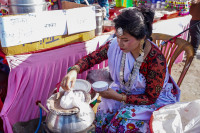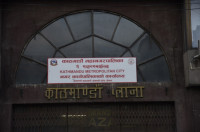Food
From Kochi to Kathmandu: a taste of Keralan cuisine comes to the Valley
Brought to Kathmandu from Kochi, the only familiarity with the kudampuli seems to be its texture. Although that too is up for debate—maybe it’s the texture of a dried apricot, perhaps a prune, but its flavour is otherworldly for the uninitiated.
Thomas Heaton
Brought to Kathmandu from Kochi, the only familiarity with the kudampuli seems to be its texture. Although that too is up for debate—maybe it’s the texture of a dried apricot, perhaps a prune, but its flavour is otherworldly for the uninitiated. Dubbed the Malabar tamarind, the seemingly fossilised jet-black version of this once-green fruit is used as a souring agent across Keralan cuisine, and its smokiness is something to behold. But kudampuli is just one small gem in the crown of Kerala’s food.
With dishes miles away from the palak paneer, naan and tandoori that most foreigners associate with Indian food, the temporary menu at the Soaltee Crowne Plaza’s Kakori restaurant marks its first Kerala Food Festival. The team at the Indian eatery had just two weeks to learn all things Kerala, corresponding with Keralan chef Rejimon SP. Chef Rejimon, a senior chef at Crowne Plaza Kochi, later joined the team to share a taste of his home with Kathmandu.
Served on a banana leaf, with gobs of chutneys and curries, a mound of rice and a disc of papad, the traditional Keralan plate is like an artist’s palette. However, Kakori is painting a more contemporary picture of the southern Indian state’s cuisine, while retaining its uniquely complex flavour combinations. It will be, according to Soaltee executive chef Yuba Raj Pokhrel, many Nepalis’ first taste of Keralan food.
Pokhrel, who spent about a decade in south India, says the cuisine can be partly characterised by its heavy use of coconut and diverse spices. Coconut pervades the Keralan menu at Kakori in many forms, as shredded, milk, roasted in chunks, and as oil; Pokhrel says there are few dishes on the menu without this ubiquitous fruit. In some, such as the tubular puttu, its presence is obvious; in others, the taste is merely an afterthought.
“You never feel like you’re eating too much of it,” says Pokhrel. “Tamil Nadu and Andhra Pradesh also use coconut, but they do it in a different way. In Kerala, they use it for all items. Whatever they make, coconut is everywhere.”
Because of the sheer amount of coconut, and the addition of curry leaves, it is also inherently healthy, he says.
Coconut constitutes the brunt of two “breads” on offer. Idiappam, a dough extruded so that it ends up looking like a pile of rice-noodle spaghetti, and appam, a bowl-like bread made of fermented rice and coconut flour, are two such items, served with various condiments. Pokhrel believes the most popular bread, by far, will be Kerala paratha. For the state’s namesake paratha, dough is fermented slightly and rolled out paper-thin. Once rolled, it is twisted and flattened again. The result is a slightly sweet bread, with hundreds of crispy and chewy layers.
The aforementioned puttu is another mixture of coconut, shredded and spiced, engulfed in rice flour, traditionally stuffed into bamboo then steamed. Kakori has opted for a modern coffee-pot tool, however, brought in from Kochi by its visiting chef. Served on banana leaf, the delicate tube disintegrates at the touch and acts as a perfect vessel to soak up the remnants of gravy, perhaps from spicy Alleppey fish curry.
That fish curry, native to the city of Alappuzha, contains the mind-boggling kudampuli. Sour and spicy, add a bite of the kudampuli and the curry jumps into another realm of complexity. Then there’s the Malabar fish curry, which has the addition of raw mangoes and coconut paste, a slightly mellower dish. Every dish is a balancing act, Pokhrel says.
“Some dishes will use tamarind, others will use kudampuli; for fish dishes, they use lemon. The sourness is often there, but it’s always totally different,” he says.
There are kappa chemmeen cutlets, dense tapioca patties seared on a hotplate and topped with a tart sauce and spicy shrimp; avial curry, laden with vegetables and drumstick, a fibrous bean-like vegetable with a slight peppery flavour; and chemmeen ularthu, a dish of blackened spicy shrimp tossed with shallots and typical Keralan spices.
The diversity of dishes on the menu speaks to the state’s history, which has been influenced by different countries and immigration from different communities. The diverse population of Hindus, Muslims and Christians has led to a cuisine unique from the rest of India’s already diverse gastronomical scene. Suriyani kozhipidi, chicken cooked with rice dumplings, is a Syrian-Christian dish; and Malabar biryani is arguably a dish of Arabic origins, for example. On the whole, however, the tastes of Kerala are fiery.
“We had to do our best to match our taste buds with this food, because if you go to Kerala, everything would be spicy,” says chef Pokhrel. “We reduced the spice level slightly, but the recipe and process is very much the same.”
While the spice has been regulated to suit Kathmandu palates, there is still hardly much else that might be familiar to this city.
“We tried to bring all of Kerala to Kathmandu, so we’ve chosen the best, both in terms of authenticity and popularity,” says Pokhrel.
The Kerala Food Festival runs at Kakori, Soaltee Crowne Plaza, until March 24.
Read other articles from our inaugural food & travel section:
— Honacha in Patan may not be the prettiest, but it is an authentic representation of Newar cuisine
— Tarebhir is perfect for a quick weekend getaway—and for some great food




 12.12°C Kathmandu
12.12°C Kathmandu










